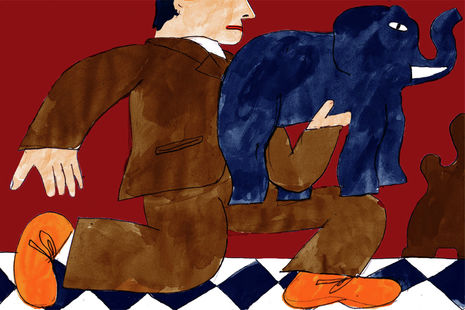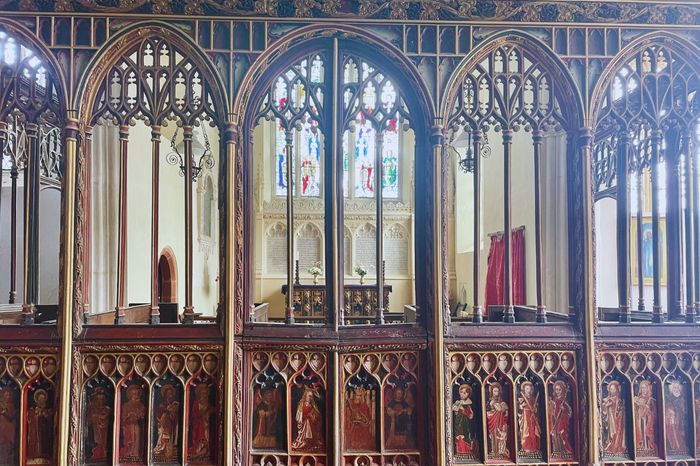The parade of the elephants
Ben Birch recounts his recent attendance of an art auction, in which he questions reality and leaves empty handed

A few weeks ago, I was on my way to a charity auction in a cathedral. It was cold and dark, and I wasn’t thrilled about the start of autumn. The cathedral was filled with thirty or so seven-foot-tall painted elephants. Intricate floral designs, an elephant covered in summer berries called ‘Fruity Frida’, and another painted in the likeness of Henry VIII, whose raised skin-coloured trunk was perhaps slightly more suggestive than the artist had intended. Then again, perhaps not – you know what artists are like. The cathedral was made of an incredible, centuries old, deep red sandstone and the contrast of the garish elephants lining the pews was very enjoyable.
“The pews were packed with pensioners and the whole place buzzed with the energy of a bingo night”
Like all successful charity events, free booze was plentiful. I think much of humanity’s charitability and generosity can be put down to the tipsiness of the super-rich. The pews were packed with pensioners and the whole place buzzed with the energy of a bingo night. The night began with some moving speeches about the important work that the charity had done — a sombreness descended throughout the audience. This was quickly dissipated as we met our hosts for the evening. The first man was an auctioneer wearing an elephant t-shirt, smiling benevolently down on his bidders. It seemed he was the person in charge. But then another voice drowned out the auctioneer’s. A man in an open collar shirt, suit trousers, and luminous orange running shoes paraded down the aisle. In another life, he could’ve been a very successful Ken Dodd impersonator, but in this lifetime, he took on the role of MC and most irritating man in the Midlands. He cracked a couple of canned jokes — the crowd tittered, simpered, and then the bidding commenced.
“An art auction is an exercise in persuasion and peer pressure; this man had mastered both”
The bidding began smoothly with the first few elephants selling for several thousand between them. Both men were mic’d up, and the roving jokester’s microphone was definitely louder than the auctioneers. As more items were sold, the energy intensified – the same jokes received bigger laughs, and the audience began to whoop and clamour as items sold for more and more. As the bidding continued, the harlequin figure for the evening began rapidly pacing up and down amongst the audience like Chris Martin and started speaking over the auctioneer. He would hold the mic very close to his mouth and, in a very breathy voice, say things like ‘go on’ or ‘you sir, I’ll lend you a tenner if you bid for three thousand pounds.’ An art auction is an exercise in persuasion and peer pressure; this man had mastered both. At one point, he promised that he would buy two plane tickets to Paris from Birmingham Airport to whoever bought one item — terms and conditions applied. At another moment, he made one of the charity workers sit in front of the camera from which online bidders were watching and had her plead into the camera for people to donate more. To his credit, the sight of a hospice worker crying ‘give us your money’ in an extreme close up definitely inspired some punters to fork out even more.
The energy of the event became increasingly frenzied – you couldn’t hear one man over the other and the tension was growing. They were like a double act who didn’t like each other, or who didn’t realise they were onstage together – they were like Coogan and Brydon, like Ronnie and Ronnie, like Jesus and John. They were competing: “we’ll do three for sixteen hundred, and we’ll split the pri-No! Four for sixteen hundred and we can split it”. It was at this point that the auctioneer left the stage. It was descending into carnival incoherence but was not done yet.
“It felt like the curtain call to an absurdist drama”
The final four items of the evening were four mini elephants about the size of an adult bernadoodle. By this point, the MC was buzzing with adrenaline. In the rush of the moment, he began picking up these elephants, slinging them over his shoulder, and running about with them while the bidding took place. The artists of these pieces were sat in the audience and his antics were met with a mixture of horror and amused incredulity. All this time, the larger elephants were being escorted out of the cathedral one by one, as if never to return. The man was visibly sweating by this point, and we could all visualise the artwork slipping away from him and smashing on the cathedral floor. I couldn’t watch and averted my eyes. As I turned away, I noticed a limestone engraving of the archangel Gabriel with his hand raised in the sign of benediction. There was certainly some grand conclusion to be drawn from the contrast of these artworks, but by this point I was too exhausted to find it.
The evening was closed out by a speech from the charity’s chairman. At the end of this speech, he asked everyone to give a standing ovation to the two men who had run proceedings. Dazed, I found myself on my feet, applauding. It felt like the curtain call to an absurdist drama. The elephants were gone, the pensioners were cheering, and the charity had received financial help which it desperately needed. I supposed that all this was worthy of an ovation.
 News / Cambridge study finds students learn better with notes than AI13 December 2025
News / Cambridge study finds students learn better with notes than AI13 December 2025 News / Cambridge Vet School gets lifeline year to stay accredited28 November 2025
News / Cambridge Vet School gets lifeline year to stay accredited28 November 2025 Science / Did your ex trip on King’s Parade? The science behind the ‘ick’12 December 2025
Science / Did your ex trip on King’s Parade? The science behind the ‘ick’12 December 2025 News / Uni Scout and Guide Club affirms trans inclusion 12 December 2025
News / Uni Scout and Guide Club affirms trans inclusion 12 December 2025 Arts / Modern Modernist Centenary: T. S. Eliot13 December 2025
Arts / Modern Modernist Centenary: T. S. Eliot13 December 2025










